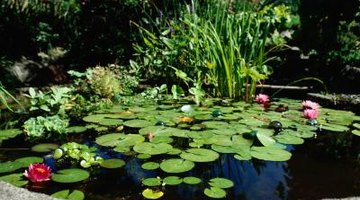How to Divert a Backyard Creek to Make a Pond
Having a creek-filled pond in the backyard can be beneficial both for recreation and utility. Ponds provide hours of enjoyment to children in the way of swimming, fishing and boating, and provide useful reservoirs of water during drought. Installing a pond in the yard that is to be fed by a creek requires some special considerations, though. You should anticipate quite a bit more labor as well as some extra footwork before beginning the project to get proper approval.

Step 1
Check with local land development offices to determine if you need any permits or surveys before beginning your project. Many creeks and small waterways are active components of local water management operations, either contributing to community reservoirs or otherwise diverting flood waters toward rivers or large bodies of water that are capable of handling the runoff. Disturbing these functions without proper permissions can pose a serious liability issue.
Step 2
Determine your final purposes for the pond. If you want to be able to keep fish in the water, you'll need to dig at least twelve to fifteen feet down in order to do so. Since the pond will be fed by a creek, you won't have the same luxury of building up the banks with the dirt from the middle the way other pond constructors do, so you'll be forced to actually dig down to the necessary depth.
Step 3
Dig away the dirt with the backhoe. Dig the pond a distance away from the creek without creating a pathway between the two. You want to completely finish preparing the pond for water before having water in it. Haul away all of the dirt from the dig, since the creek can only feed the pond if the pond lies below the water level of the creek.
Step 4
Apply a layer of clay soil to the pond to help with water retention. The weight of the heavy machinery driving around the pond bed should sufficiently compact the clay soil and seal it for water retention.
Step 5
Dig a small channel between the creek and the pond with the backhoe. This part is easiest when done from the pond to the creek rather than vice versa, as digging in watery areas will create a murky workspace. Get permission from any neighbors who may also enjoy the creek before doing so, as this will inevitably cause the creek to run dry for a while as the pond fills.
References
Photo Credits
- Ryan McVay/Photodisc/Getty Images
More Articles



